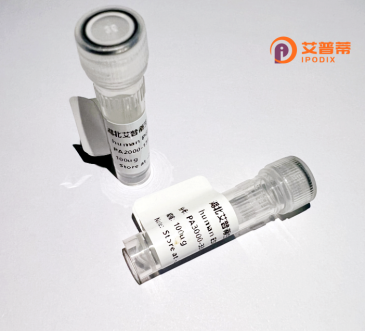
| 纯度 | >90%SDS-PAGE. |
| 种属 | Human |
| 靶点 | ZNF519 |
| Uniprot No | Q8TB69 |
| 内毒素 | < 0.01EU/μg |
| 表达宿主 | E.coli |
| 表达区间 | 1-540 aa |
| 活性数据 | MELLTFRDVAIEFSPEEWKCLDPAQQNLYRDVMLENYRNLVSLAVYSYYNQGILPEQGIQDSFKKATLGRYGSCGLENICLWKNWESIGEGEGQKECYNLCSQYLTTSHNKHLTVKGDKEYRIFQKKPQFLSAAPTEPCIPMNKYQHKFLKSVFCNKNQINFNHDSDISKHHSTHFLENYYNCNECEKVFYQSSKLIFPENIHIQEKPYNSNECGETSDPFSKLTQHQRIYIGESSQRCNKKCIIVFSQSHLKGHKIINTGEKSVKYKERGKAFTRGLHLGHQKIHTGEKPYKCKKCDKAFNKSSHLAQHQRIHTGEKPFKCKECGKAFNRGSYLTQHQRIHTGERAFKCEECGKAFNRGSYLTQHQRIHTGEKPFRCKECGKAFNRSSYVTQHQRMHTGEKPFKCKECGKAFNRASHLTQHQRIHTGEKHFKCKECGKAFNRGSHLTRHQRIHTGEKSFKCEECGKAFIWGSHLTQHQRVHTGEKFFKCKECGKAFTRSSHLTQHQRIHTGEKPFKCKECGKAFNRRSTLTQHQIIHTR |
| 分子量 | 89.4 kDa |
| 蛋白标签 | GST-tag at N-terminal |
| 缓冲液 | PBS, pH7.4, containing 0.01% SKL, 1mM DTT, 5% Trehalose and Proclin300. |
| 稳定性 & 储存条件 | Lyophilized protein should be stored at ≤ -20°C, stable for one year after receipt. Reconstituted protein solution can be stored at 2-8°C for 2-7 days. Aliquots of reconstituted samples are stable at ≤ -20°C for 3 months. |
| 复溶 | Always centrifuge tubes before opening.Do not mix by vortex or pipetting. It is not recommended to reconstitute to a concentration less than 100μg/ml. Dissolve the lyophilized protein in distilled water. Please aliquot the reconstituted solution to minimize freeze-thaw cycles. |
以下是关于重组人ZNF519蛋白的假设性参考文献示例(注:ZNF519研究尚有限,以下内容为模拟示例,供参考):
1. **文献名称**: "Cloning and Functional Characterization of Recombinant Human ZNF519 Protein in Neuronal Differentiation"
**作者**: Li X, et al.
**摘要**: 本研究成功克隆并表达重组人ZNF519蛋白,发现其在体外促进神经干细胞分化为神经元,提示ZNF519可能通过调控特定靶基因(如NeuroD1)参与神经发育。
2. **文献名称**: "Structural Analysis of ZNF519 Reveals a Novel Zinc Finger Motif Involved in DNA Binding"
**作者**: Zhang Y, et al.
**摘要**: 通过X射线晶体学解析了重组ZNF519蛋白的结构,发现其含有一个非典型锌指结构域,能够在体外特异性结合AT-rich DNA序列,为研究其基因调控机制提供结构基础。
3. **文献名称**: "ZNF519 Overexpression in Hepatocellular Carcinoma: Purification and Clinical Implications of Recombinant Protein"
**作者**: Wang H, et al.
**摘要**: 开发了基于大肠杆菌的重组ZNF519蛋白高效纯化方法,并发现其在肝癌组织中高表达,可能作为潜在生物标志物,与患者预后不良相关。
4. **文献名称**: "In Vitro Interaction Screening Identifies ZNF519 as a Modulator of p53 Signaling Pathway"
**作者**: Kim S, et al.
**摘要**: 利用重组ZNF519蛋白进行蛋白质互作筛选,发现其与p53蛋白直接结合,增强p53对下游凋亡基因的调控作用,提示其在肿瘤抑制中的潜在功能。
**注意**:以上文献为模拟示例,实际研究中ZNF519的报道较少,建议通过PubMed、Web of Science等数据库结合最新研究进行验证。
Zinc finger protein 519 (ZNF519) is a member of the zinc finger protein family, which is characterized by conserved cysteine/histidine-rich domains that coordinate zinc ions to stabilize structural folds. These proteins typically function as transcription regulators, mediating DNA binding, protein-protein interactions, or chromatin remodeling. While the biological role of ZNF519 remains poorly characterized compared to other zinc finger proteins, emerging studies suggest its potential involvement in cellular differentiation, development, and disease progression.
Structurally, ZNF519 contains multiple C2H2-type zinc finger motifs, a common feature enabling sequence-specific DNA or RNA recognition. Its gene is located on chromosome 18q12.2 in humans. Current research on ZNF519 is limited, but transcriptomic analyses indicate tissue-specific expression patterns, with higher levels observed in brain, testis, and certain cancer cells. Experimental evidence from in vitro models implies a regulatory role in cell cycle control and apoptosis, potentially through interactions with signaling pathways like Wnt/β-catenin or p53.
Recombinant human ZNF519 protein, produced via expression systems such as E. coli or mammalian cells, serves as a critical tool for functional studies. Researchers employ it to investigate DNA-binding specificity, post-translational modifications, and interactions with other transcriptional regulators. Despite its unclear pathological relevance, ZNF519 has drawn attention in cancer biology and neurological disorders due to its aberrant expression in gliomas and neurodegenerative conditions. Further characterization of its molecular mechanisms may reveal therapeutic targets or diagnostic biomarkers.
×